
The hearty band of trainers, comprised of graduate students, undergraduate students, alumni and volunteers from the Urbana-Champaign community. Photo by Anne Anderson.


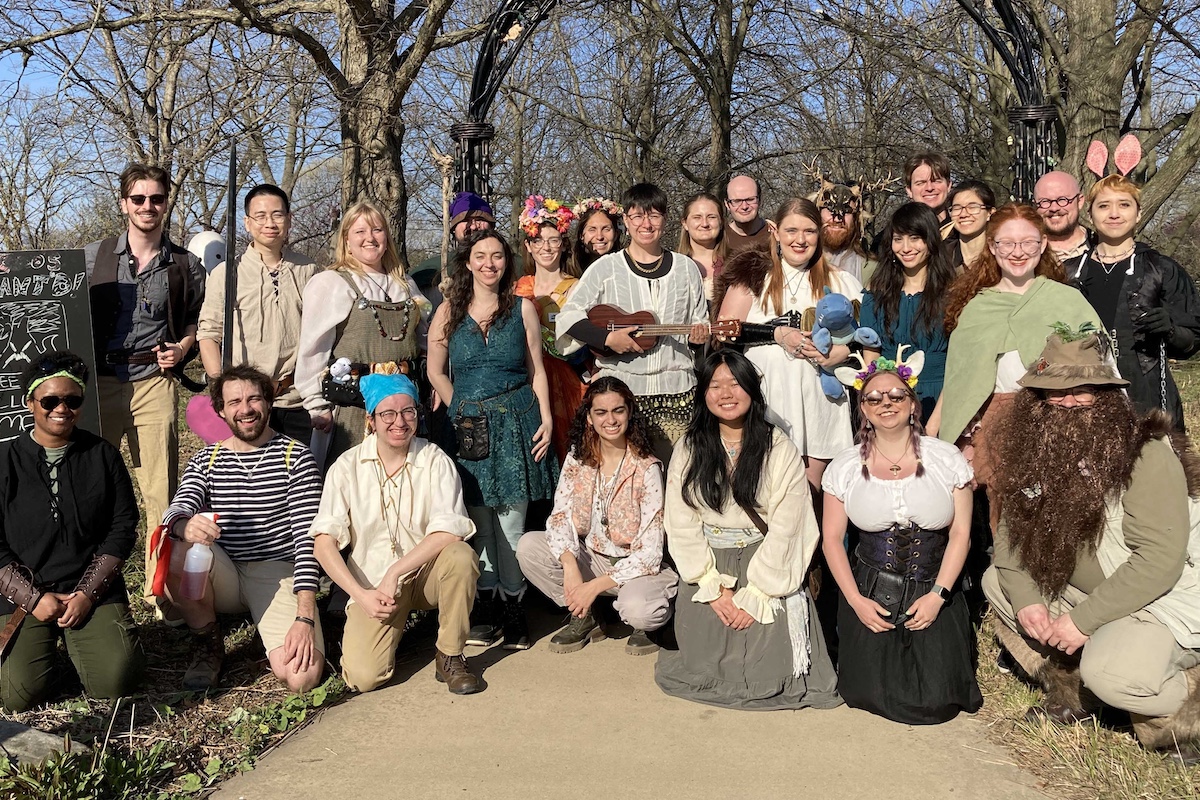
The hearty band of trainers, comprised of graduate students, undergraduate students, alumni and volunteers from the Urbana-Champaign community. Photo by Anne Anderson.
It was a beautiful April Saturday afternoon at the Anita Purves Nature Center, a public education center nestled between Crystal Lake Park and Busey Woods in Urbana. It was not surprising to see families from the surrounding area exploring the exhibits in the Nature Center itself or taking peaceful strolls along the boardwalk through the nearby woods. Unexpected, however, were the visitors donning medieval and fantasy dress, some with dragon wings on their backs, others carrying foam swords in their hands, hotly debating the best type of biological control agent for dealing with rampaging owlbears.
These aspiring adventurers were at the Nature Center on a quest, recruited to take part in training activities to combat the incursion of invasive species into central Illinois. But these are no ordinary invasives: blink dogs, faerie dragons and other wonderous creatures from the Feywild, (a magical plane that exists adjacent to our own), have invaded and are wreaking havoc on the local wildlife. Or, at least, that was the narrative presented by a mix of graduate and undergraduate students, alumni, and colleagues from the University of Illinois, attracting people to a new and unique scientific outreach event.
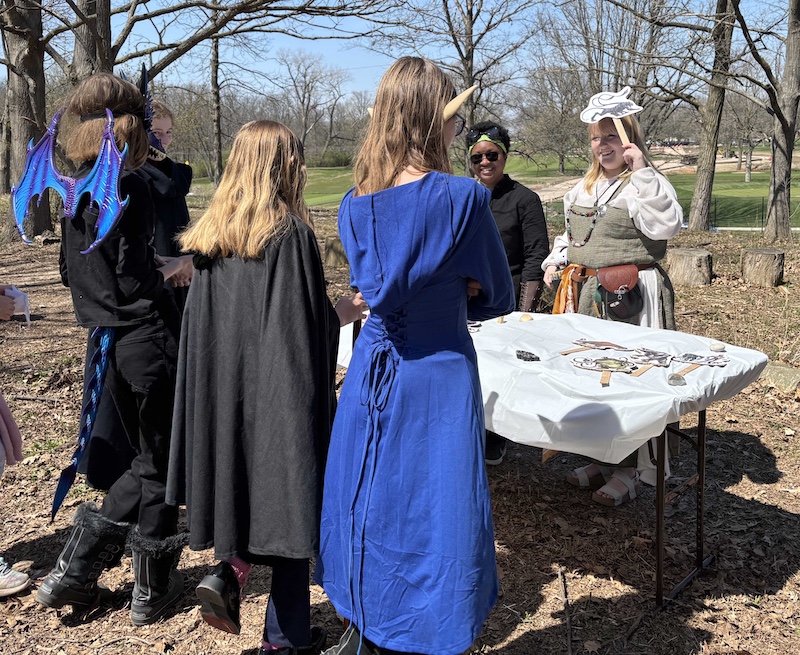
The winged visitor was debating the pros and cons of using biological control agents (BCA) to combat invasives with three experts in the field of magical creatures (graduate students Johanna and Avi and undergraduate Sophia). Discussions of whether to use Umber Hulks (giant burrowing creatures) to control the population of marauding Kruthiks (violent invasive creatures) sounds like pure fantasy. However, having visitors consider questions of whether the Umber Hulk will target the Kruthiks, how effective they will be and whether they introduce a new problem to be controlled at a later time, touches upon real life considerations when introducing BCAs. Will the use of another introduced species be a success, such as the use of Desmodium to control the spread of witchweed, or a disaster, like the introduction of cane toads in Australia.
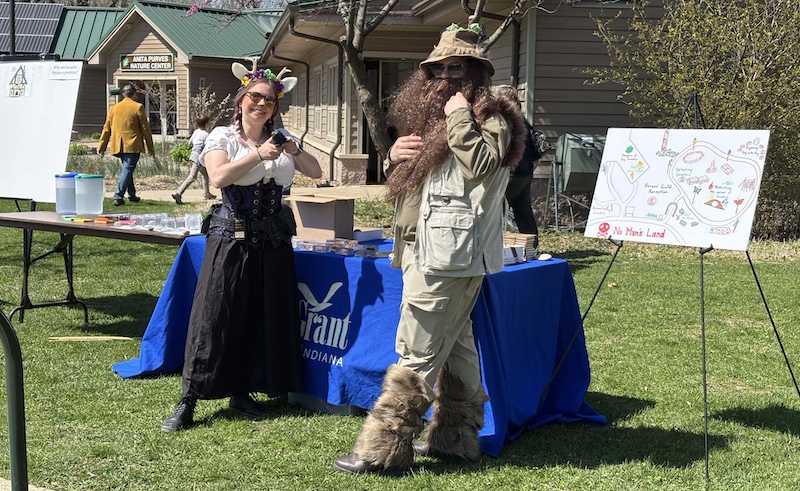
When visitors first arrived at the entrance to the training fields, they were greeted and briefed on their mission by Dr. Bruce Bruceson, a master druid and visiting professor from the Sugar and Spice Academy in the Feywilds and his graduate student F’lorah Ferncoat. These characters were played by the primary organizers of the event, University of Illinois Urbana-Champaign evolution, ecology and behavior professor Philip Anderson and his graduate student Avalon Feiler.
The event itself was a joint effort organized by Dr. Anderson’s lab at the University of Illinois and Cosplay for Science. Cosplay for Science is an initiative that researches and implements best practices in science communication, using an innovative approach of “cosplay” in which scientists participate in an immersive experience for general audiences built on popular culture such as science fiction or fantasy worlds. In this instance, the theme was fantasy adventure, drawing upon sources like the table-top roleplaying game of Dungeons and Dragons. While the theme was fantastical, the science is very real, addressing the real-world challenges and dangers invasive species bring to local wildlife and ecosystems.
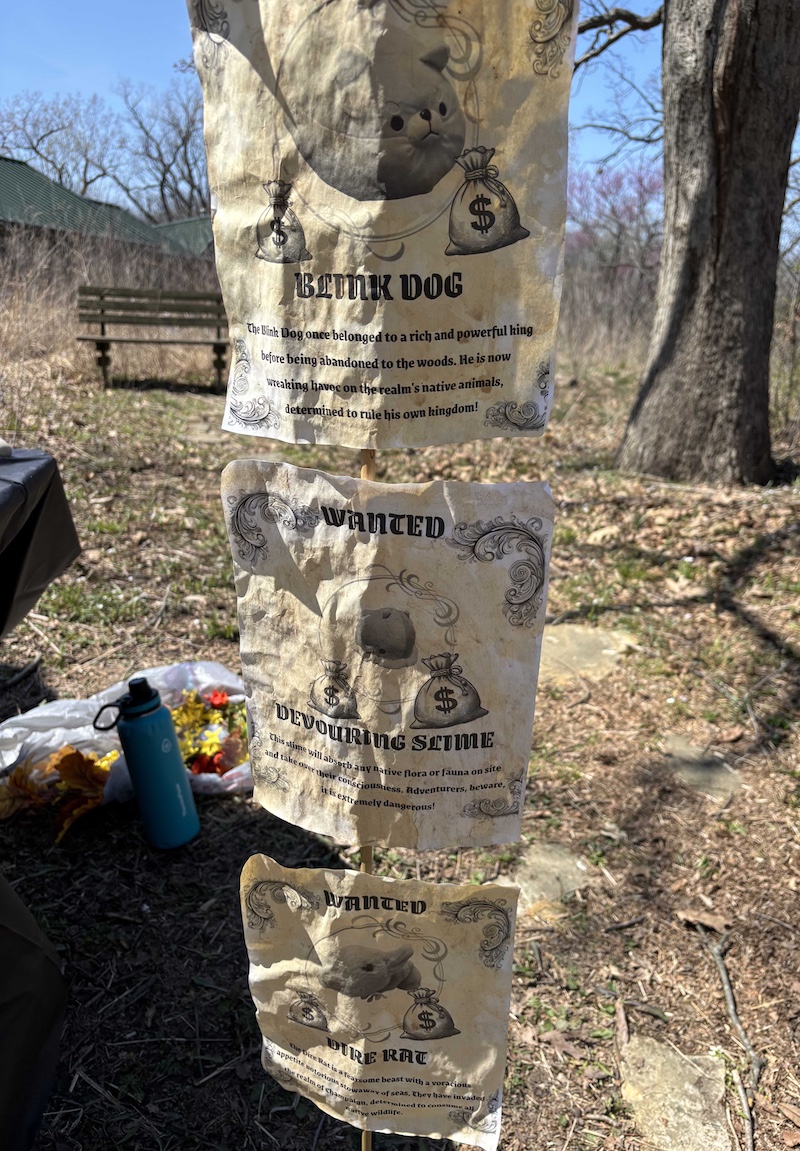
Once given their mission, and a brief overview of the layout of the event on a nearby map, potential adventurers visited seven stations. Each station was attended by a group of volunteers in full fantasy character, accent and all, who not only introduced the goal of the activity, but placed it in the greater context of invasion biology, all while keeping to the narrative of an invasion of magical creatures.
At one station, a group of druids and rangers well-versed in tracking and searching (undergraduates Olivia and Layla, lab technician Katrina and community volunteer Kayla) taught visitors how to detect these magical invasive species early on, before they can become established. By solving a matching puzzle, visitors received clues about what environments certain invasives (such as a magical blink dog) may be drawn to. This matching puzzle, presented as the nature spell Detect Native Anomalies, was based on eDNA methods. Visitors matched base pairs between known segments from invasive creatures and those found in nearby locations, allowing them to track down the invasives and learn a little about how scientists can identify invasives in a local environment before they even see them.
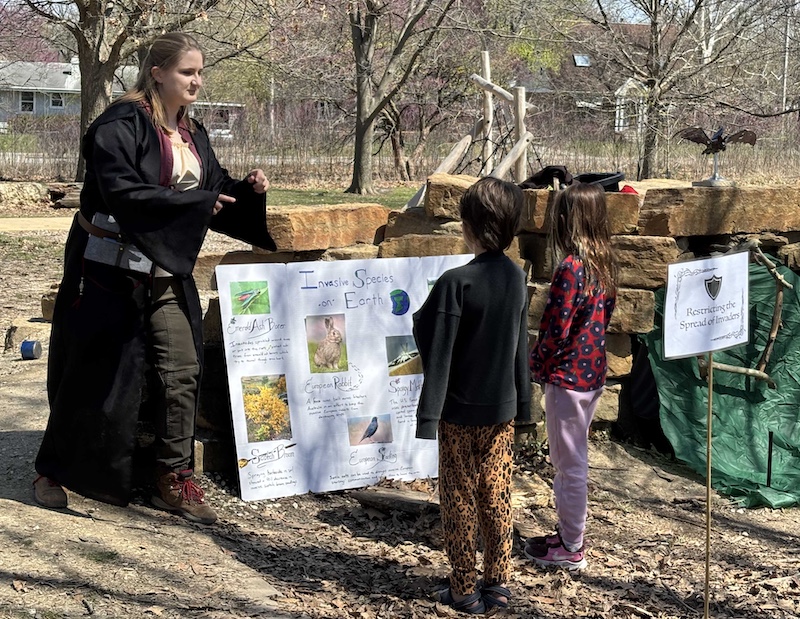
Another station, run by a trio of wizards Alex (UIUC graduate student), Maddy (UIUC alumni) and Matt (community volunteer), asked visitors to choose a specific magical spell to create barriers against the spread of invasive species. The activity required understanding what each magical invasive creatures may be weak to, similar to how actual barriers are erected to prevent the spread of invasives in the real world. As an example, Kelpie (half-horse, half-fish creatures) are scared of lighting storms, making lightning spells effective at preventing them from spreading in lakes and rivers. The wizards highlighted the parallel to the use of electrical barriers to try and prevent the similar spread of Asian carp. Fae bats are easily distracted and warded off by the casting of wind spells, similar to how European starlings can be driven from areas using sonic nets. Some analogies were more obvious. Bodytaker plants (dangerous, carnivorous invasive plants) can be removed via the application of poison spells in the same way we use herbicides on real invasive plants. While young visitors had fun “casting spells” (throwing colored balls through a target), they were also learning the lesson of how understanding the biology of an invasive species is key to finding methods to prevent their spread.
Those adventurers who wished to get more hands-on training could go on an expedition with Jules (graduate student), Wilfred (graduate student) and Dzenan (undergraduate). These fighters/barbarians recruited sturdy adventurers to remove nasty Feywild twig blights disguised as honeysuckle from the nearby Busey Woods. Through the use of a variety of tools (foam swords, magical herbicide and even an Extractigator), they taught visitors that sometimes it is necessary to get your hands dirty and using the right tools to physically remove invaders.
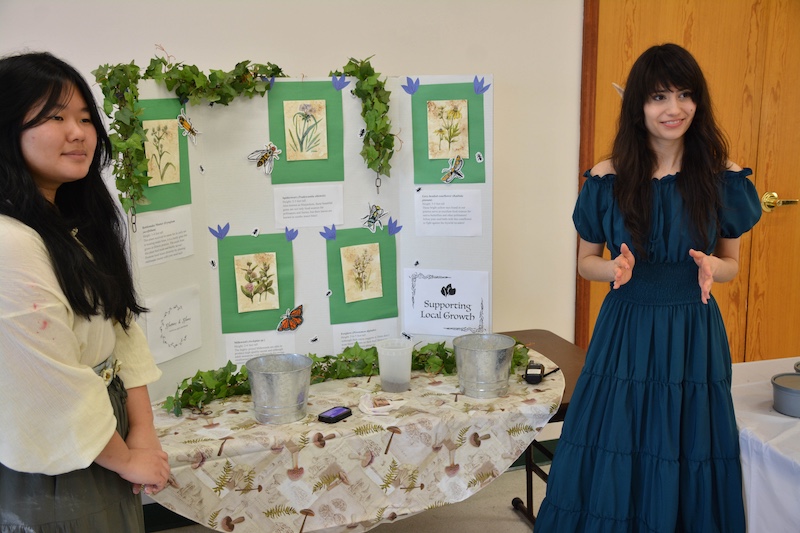
Visitors who wanted to get their hands dirty in a way that adds-to rather than removes-from the environment, could enter the Nature Center and visit Flora and Elmyra’s Mystical Seed Emporium. These two elven ladies (graduate student Rebecca and undergraduate Rose) taught hands-on druidcraft to visitors eager to combat invasives by supporting and encouraging native growth. The “druidcraft” in this case was constructing seedballs that visitors could take home with them using a range of local seeds.
Rounding out the day, visitors spent time learning about ecosystems via a custom-made board game created by University of Illinois graduate student Aiden and run by Karter (Illinois-Indiana Sea Grant) and Brian (community volunteer). Afterwards, they reflected on all that they had learned and how they could help bring attention to the importance of protecting local ecosystems with a trio of bards (Graduate students Adrien and Lauren and Illinois-Indiana Sea Grant researcher Katie).
As they finished, the crowds of people whose attention we had captured with our unconventional outreach returned to Dr. Bruce and F’lorah to receive a small reward for getting every page of their adventure guide stamped, showing that they had completed the training. It brought a smile to my face knowing how many people we had been able to reach, how much fun they had, and that they all walked away having learned something new.
This event was months in the making. Both it and the prior event we ran in September 2024 would not have been possible without a team of dedicated and passionate volunteers from both the University of Illinois and surrounding Urbana-Champaign community. We are also grateful to all the support we received from the Illinois Extension, Illinois-Indiana Sea Grant and the Urbana Parks District. We hope moving forward to continue to build upon this foundation; creating fun events and activities that inspire a sense of wonder and appreciation for the natural world.
Philip Anderson is an associate professor in the Department of Evolution, Ecology, and Behavior at the University of Illinois who studies evolutionary biomechanics across a range of organisms, including vertebrates, invertebrates and plants. Using a combination of experimental and theoretical analyses, he addresses how fundamental laws of physics influence evolutionary processes with a current focus on the mechanics and evolution of biological puncture/injection systems and the evolution of multi-part biomechanical systems. When not performing research or teaching anatomy and biomechanics, he spends his free time playing a range of characters in Dungeons and Dragons and other TTRPGs, a hobby which he is now leveraging to get a broader public audience interested in science.
Submit a question for the author